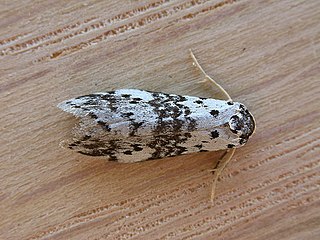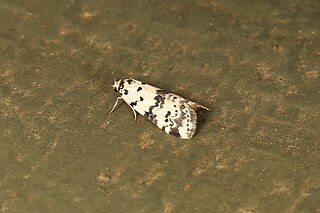
Thallarcha fusa is a species of moth of the subfamily Arctiinae. It was first described by George Hampson in 1900 and it is found in Australia.

Thallarcha albicollis is a moth of the subfamily Arctiinae first described by Rudolf Felder and Alois Friedrich Rogenhofer in 1875. It is found in Australia, including Tasmania.

Thallarcha partita is a moth of the subfamily Arctiinae first described by Francis Walker in 1869. It is found in the Australian states of New South Wales, Queensland and Victoria.

Thallarcha sparsana, the fair footman, is a moth of the subfamily Arctiinae. The species was first described by Francis Walker in 1863. It is found in the Australian states of Victoria, New South Wales and Queensland.

Thallarcha is a genus of moths in the subfamily Arctiinae.
Thallarcha jocularis is a moth of the subfamily Arctiinae first described by Rudolph Rosenstock in 1885. It is found in the Australian states of New South Wales and Victoria.
Thallarcha catasticta, the four-lined footman, is a moth in the subfamily Arctiinae. It was described by Oswald Bertram Lower in 1915. It is found in Australia, where it has been recorded from New South Wales, South Australia, Victoria and Western Australia.
Thallarcha chrysochoa, the golden footman, is a moth in the subfamily Arctiinae. It was described by Edward Meyrick in 1886. It is found in Australia, where it has been recorded from the Australian Capital Territory, New South Wales and Victoria.
Thallarcha epileuca is a moth in the subfamily Arctiinae. It was described by Turner in 1922. It is found in Australia, where it has been recorded from Queensland.
Thallarcha epiostola is a moth in the subfamily Arctiinae. It was described by Turner in 1926. It is found in Australia, where it has been recorded from Tasmania, New South Wales and Victoria.
Thallarcha erotis is a moth in the subfamily Arctiinae. It was described by Turner in 1914. It is found in Australia, where it has been recorded from New South Wales and Queensland.
Thallarcha isophragma is a moth in the subfamily Arctiinae. It was described by Edward Meyrick in 1886. It is found in Australia, where it has been recorded from Tasmania.
Thallarcha leptographa is a moth in the subfamily Arctiinae. It was described by Turner in 1899. It is found in Australia, where it has been recorded from New South Wales and Queensland.
Thallarcha levis is a moth in the subfamily Arctiinae. It was described by Turner in 1943. It is found in Australia, where it has been recorded from the Northern Territory and Queensland.
Thallarcha macilenta is a moth in the subfamily Arctiinae. It was described by Thomas Pennington Lucas in 1894. It is found in Australia, where it has been recorded from New South Wales and Queensland.
Thallarcha oblita, the hidden footman, is a moth in the subfamily Arctiinae. It was described by Rudolf Felder and Alois Friedrich Rogenhofer in 1875. It is found in Australia, where it has been recorded from the Australian Capital Territory, New South Wales and Victoria.
Thallarcha phalarota, the adorned footman, is a moth in the subfamily Arctiinae. It was described by Edward Meyrick in 1886. It is found in Australia, where it has been recorded from the Australian Capital Territory, New South Wales, Queensland and Victoria.

Thallarcha rhaptophora is a moth in the subfamily Arctiinae. It was described by Oswald Bertram Lower in 1915. It is found in Australia, where it has been recorded from New South Wales, Victoria and Western Australia.
Thallarcha staurocola is a moth in the subfamily Arctiinae. It was described by Edward Meyrick in 1886. It is found in Australia, where it has been recorded from New South Wales, Queensland and Victoria.





